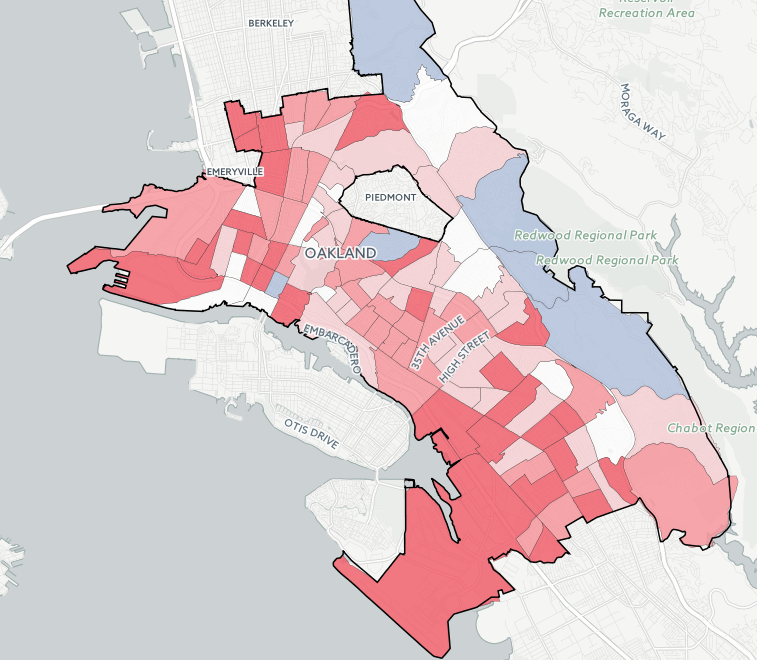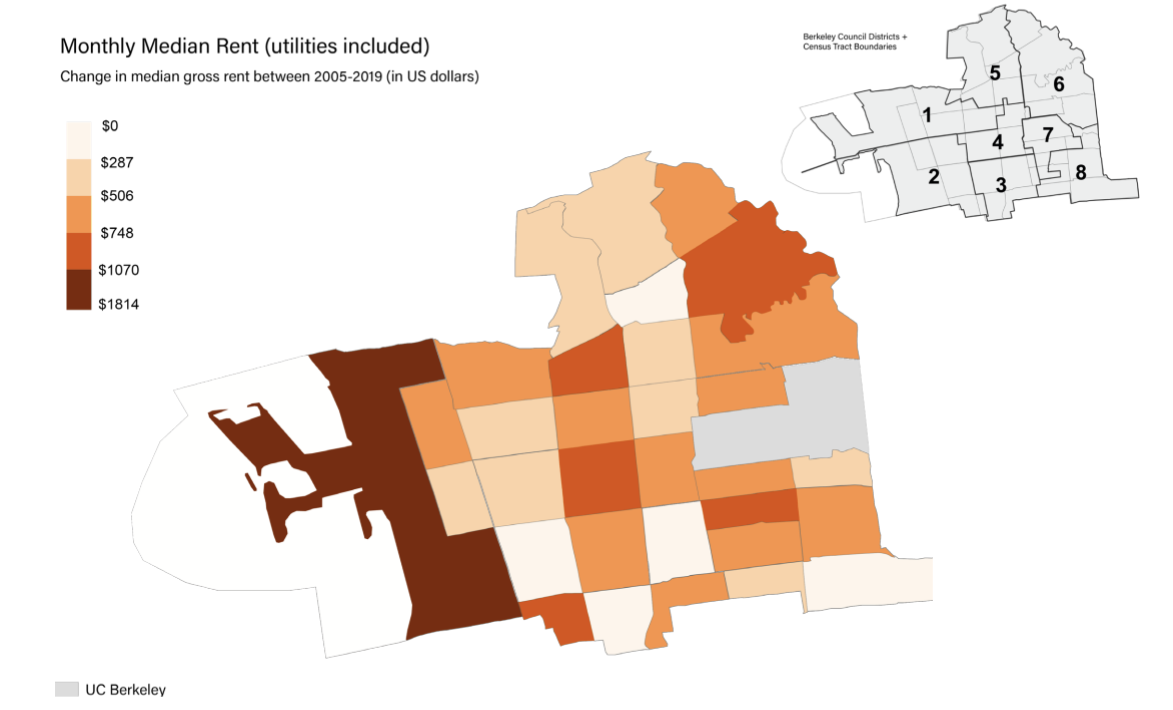Author: Juan Pablo De Anda Castaneda, Graphics: Business Review at Berkeley
As gentrification reshapes Berkeley and Oakland, rising rents and changing demographics threaten small businesses, making community-driven policies crucial for their survival.
The Economic Effects of Gentrification on Small Businesses
Gentrification has rapidly reshaped neighborhoods in the Bay Area in recent years. With the consistently decreasing amount of affordable housing, yearly gentrification has displaced many longtime residents while contributing to the unequal distribution of wealth across the area. These changes have reshaped the dynamic of many neighborhoods, from who lives in these neighborhoods to the stores on the streets and the “vibes” of these areas. This immediately impacts all the businesses in the area, forcing local small businesses to close down while big companies with greater capital and popularity take over. The result is a shift in neighborhood character — one that raises urgent questions about economic equity, cultural preservation, and who gets to belong in the evolving Bay Area.
Displacement in Rockridge and International Boulevard
The Rockridge neighborhood in Oakland is a prime exemplifier of gentrification, where the character of the area has changed as house prices have increased in recent decades. As the area has become populated with wealthy residents, the neighborhood’s culture and businesses have changed as well, becoming unaffordable for low-income residents of the adjacent neighborhoods. This phenomenon has been clearly described by a long-time resident in Oakland North’s July 2011 article: “When I was growing up in Oakland, I remember watching, year after year, the Rockridge shopping district becoming posh. (…) Nowadays, south of Bushrod, aside from a couple of bars and hair salons, there is no social business between Shattuck and Telegraph any longer.”
The International Boulevard Corridor, a nine-mile arterial road that cuts through East Oakland’s working-class neighborhoods, also shows the impact of large-scale development projects on small businesses and the displacement of low-income communities in Oakland. A map tracking rent increases across Oakland between 2000 and 2013 highlights how neighborhoods surrounding International Boulevard have experienced some of the steepest rises in rent—contributing directly to the displacement of long-standing residents and businesses.

As concluded in a report by the Lawyers’ Committee for Civil Rights of San Francisco, “The nine-mile stretch, historically home to a diverse mix of immigrant- and minority-owned businesses, cultural landmarks, and community institutions, has been deeply affected by rising rents and changing demographics.” The report highlights how the Bay Area’s Bus Rapid Transit (BRT) development has accelerated gentrification and displaced long-standing businesses. Berkeley’s Fourth Street district replaced former small grocery stores with high-end stores and restaurants, such as Cody’s Books and Market Hall Foods. The competitive market in West Berkeley, which has experienced significant rent increases over time, has contributed to a sharp rise in commercial rents —particularly in areas like Fourth Street, which is part of the district that contains 47% of Berkeley’s total retail space, the highest concentration in the city. As a result, many long-standing small businesses have been forced out, and housing prices in the surrounding neighborhoods have also been affected. Thus, it is becoming more difficult for these businesses to stay open due to the high rents and operating costs. The local business landscape is rapidly transforming, with new boutiques, upscale restaurants, and high-end developments replacing many long-standing small businesses. According to a 2022 report by the Anti-Eviction Mapping Project, median gross rents in Berkeley increased by over 50% between 2005 and 2019.

Small Businesses Adapting to Gentrification
Despite a great number of small businesses struggling to survive gentrification, some find ways to adapt to the current economy. Some businesses have adjusted by modernizing their operations — for example, renovating their spaces, updating their marketing strategies, or rebranding entirely — and expanding their target audience. In Oakland, the great impact of gentrification on small businesses is evident in the struggles faced by long-standing, family-run restaurants. Many food establishments have been forced to adapt or close due to the high rents and business costs. Restaurants like Lo Coco’s and Asmara have had to renovate their interiors and update their offerings to survive in an evolving market now characterized by wealthier clientele and shifting demographics.
However, many businesses are unable to adjust to the changes brought by gentrification. This could be due to a lack of resources, capital or the ability to serve wealthier customers, leading to struggles and a lot of time closure. An overwhelming 93% of low-income neighborhoods in Oakland and 75% in Berkeley are at risk of gentrification or already experiencing it, according to data cited by Kathleen Richards, a journalist focused on housing and economic issues in the Urban Displacement Project. These figures highlight the scale of displacement facing vulnerable communities and underscore the urgent need for policy changes that protect small businesses while still allowing for sustainable economic growth. These numbers showcase the urgent need for policy changes that will protect small businesses while still finding ways to continue economic growth.
Community Responses and Policy Interventions
Local Pressures of Urban Development
The Bay Area has experienced significant urban development, with an influx of affluent residents and big-name brands moving to the region—as seen in areas like Oakland’s Temescal Telegraph Business District, where stores like Shoe Palace have opened in recent years. Yet Randy Shaw, a housing advocate and director of the Tenderloin Housing Clinic in San Francisco, praises Oakland’s economic stabilization efforts, such as “rent control, just-cause eviction laws, and grassroots activism” for their effectiveness in limiting displacement and maintaining a certain level of economic diversity.
Berkeley’s Cooperative Policies
Berkeley City Council measures align with the trends of neighboring cities. To reduce the negative effects of gentrification, growing community activism, tenant protections, and cooperative businesses are helping to address these challenges and, in some cases, have led to solutions. For example, Berkeley’s 2016 decision to support worker-owned cooperatives provides tax benefits and educational support. It prioritizes co-ops for certain businesses that struggle with the rising costs brought by gentrification.The City Council reinforced its commitment in 2016 by providing tax and land-use incentives, educational resources and by prioritizing co-ops in city procurement processes, helping local entrepreneurs keep their stores open.
A Balanced Approach for Community Preservation
The cases of Berkeley’s Fourth Street and Shattuck co-op businesses, as well as Rockridge and the International Boulevard in Oakland, show that gentrification is a process shaped by policies, advocacy, and economic decisions.
As Randy Shaw posits, “Business growth and urban change do not always have to result in displacement; with the right policies, cities can foster economic development while ensuring long-time residents and small businesses are not forced out.” Therefore, while cities continue to progress, it will be essential to balance economic growth with community preservation. The goal should be to guarantee that longstanding businesses and residents are not displaced but can coexist and thrive in our evolving urban landscape.
Take-Home Points
- Rising property values in areas like Rockridge and Fourth Street have displaced low-income residents and small businesses, altering the local cultural and economic landscape.
- While some small businesses have adjusted their operations to survive, many lack the resources to adapt and are forced to permanently close.
- Policy efforts such as rent control, just-cause eviction laws, and cooperative business support have played a key role in stabilizing local economies and preventing displacement.
- With the right policies and community efforts, economic development does not have to come at the cost of small business displacement.

